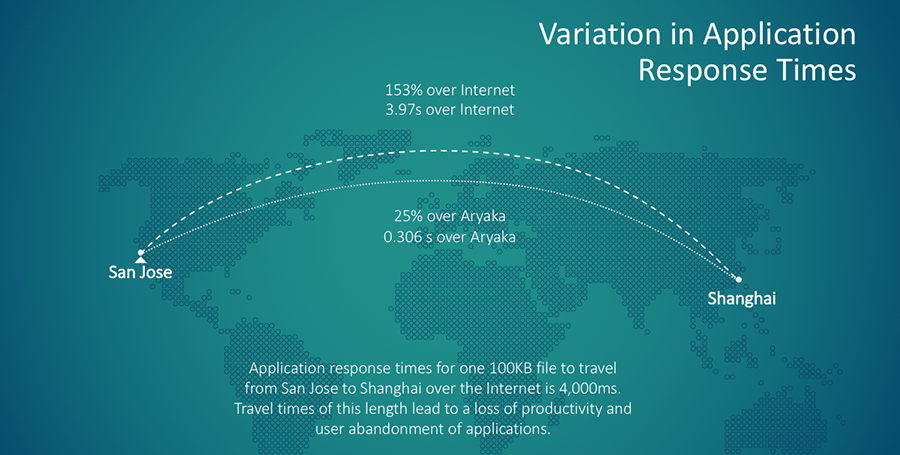SD-WAN in Asia-Pacific: What to Look For

The Asia-Pacific region (APAC) is a burgeoning hub of global business. More and more enterprises are turning to this developing area to outsource and expand, which typically results in straining the network resources used to support real-time collaboration among worldwide teams.
Combine that fact with the enterprise shift to cloud computing, and you get a whipsaw effect that can cause major headaches for global enterprises. Data to and from the cloud makes up 50% of WAN traffic today, according to a recent State of the WAN report, but legacy point-to-point WAN technologies make it almost impossible to extend optimized connections to global cloud resources.
As a result of traffic growth to APAC and the shift to cloud, many organizations have tried to use the Internet to supplement their MPLS backbone networks, learning the hard way that the best effort, public Internet composed of links from a range of service suppliers is not a corporate WAN.
To put that reality in context, Aryaka conducted a series of tests to measure the reliability of the public Internet as a medium for these critical corporate links. The results, which you can read in our SD-WAN Connectivity report, were stark for the APAC region:
- The average application response time in APAC to access a resource hosted in US was as high as 4,000 milliseconds.
- Average variability in response times was up to 153%.

It is frustrating enough to experience long delays waiting for applications to respond, but all the worse when wait times waver all over the place. And for companies using Unified Communications as a Service (UCaaS) tools to communicate and collaborate in real time, the performance issues translate into constant lag, freezing, or dropped calls.
As the study shows, the APAC region is especially prone to these problems because the infrastructure is still being developed. Even users connecting within the region — reducing the risk of latency caused by distance — may experience application delays because the infrastructure there was not designed to handle today’s traffic levels.
Is Hybrid Better?
Given that legacy MPLS networks are point-to-point and cannot connect end users to the cloud, some IT shops thought the answer was to build hybrid networks using SD-WAN appliances. Installing appliances at remote locations makes it possible to split out traffic to the Internet from the branch office and route those connections to cloud resources.
Beside the fact that this approach relies on the flaky public Internet for critical corporate traffic, there are two other problems:
- SD-WAN links typically are not optimized, meaning bandwidth requirements will be high and the excess traffic will exacerbate the problems that stem from using the Internet in the first place.
- Cloud resources such as Microsoft Office 365 have to be housed in one location, which will greatly degrade the performance of users in overseas shops who have to rely on the Internet to reach back to the serving data center.
Though SD-WAN has been positioned as the “cure-all” for legacy WAN issues, it should be noted that not all SD-WANs are the same. Unless you select an SD-WAN solution that is based on a global private backbone, SD-WAN will not adequately address your application performance issues.
A True Global Alternative

What should you look for in your SD-WAN solution to support your growing APAC network operations? Here are a few suggestions:
It must be global. Neither MPLS nor SD-WAN appliances are the answer when you’re looking for higher bandwidth and cloud-native support to address your burgeoning global network needs. MPLS doesn’t have the cloud support required, takes forever to modify and is expensive, and SD-WAN appliances introduce new problems with their reliance on the Internet. An SD-WAN that is delivered as a service over a private global network is fast to deploy, agile, cost effective, and supports cloud and on-premises resources anywhere in the world.
It must optimize your traffic. WAN traffic growth to regions like APAC will continue to outstrip local efforts to keep up with that growth for the foreseeable future. That makes WAN traffic optimization a priority if the goal is to deliver optimal application performance. Most SD-WAN providers can’t offer that, so choose wisely.
It must work with all cloud and SaaS platforms and applications. Your WAN should be able to connect end users seamlessly to all your business-critical applications. This means more than purchasing direct connections to AWS and Azure; this means supporting traffic flowing from any and all direct connections along the middle mile. This also means not having to backhaul your connectivity through the data center, losing out on the benefits of any WAN optimization capabilities you have in place.
It must be reliable and stable. Your global WAN shouldn’t force you to sacrifice enterprise-grade security and stability for application connectivity. Don’t let SD-WAN appliance suppliers convince you to give up on SLAs because your ERP demands cloud connectivity. Your WAN should ensure that your global workforce can get their work done without losing out on reliable connections or wasting time waiting for their data to load.

If you’re looking for a global WAN that meets all these requirements, check out Aryaka’s Managed SD-WAN solution. To discover how Aryaka can improve your application performance in APAC and beyond, contact us today.







